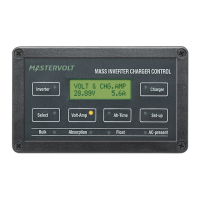18 November 2004 / Masterlink MICC / EN
6 HISTORICAL DATA
To know the history of your battery can be very
useful. It will help you to check if the battery is
has the right capacity for the application, and
how long the battery can be used before it need
to be replaced. This can be done by reading the
number of cycles the battery has used, and the
efficiency (C.E.F.) of the battery. The memory
back up system of the MICC makes this data
available even if the power supply of the meter
removed or, if the battery completely discharged
to 0 volts.
For more information see also the set-
up drawing (figure 7). The numbers of
the mentioned levels correspond with
this drawing.
Battery history data (H01)
To enter the historic data menu press the Set-
up button once. With the Select button you can
scroll trough a total of 6 information levels.
Deepest discharge (H02)
By touching the Select-button once, the
deepest discharge of the battery is displayed.
This value lets you know the deepest discharge
of the battery since power up of the MICC or
after a historic data reset. For an optimum
lifetime of your battery it is advised not to
discharge a battery below 80 % of its rated
capacity. If a battery is frequently discharged
below this value, premature failure of the battery
can be expected.
Peukert exponent (H03)
The second level shows the Peukert exponent.
Standard batteries are rated for a 20-hour
discharge. This means that a 100 Ah battery
can supply 5 amps for 20 hours before a
voltage of 1,75 volt/cell (10,5 volt for 12-volt
batteries and 21 volt for 24-volt batteries) is
reached.
If the discharge current is higher, for example
10 amps the battery will not be able to supply
the full 100 Ah. In this case the voltage of
1,75 volt/cell or 10,5/21 volt is reached before
the battery has supplied its full 20-h rated
capacity. Frequently discharging the battery
below this voltage and/or capacity will shorten
the life of the battery dramatically.
The maximum time the battery can be used in
the above mentioned example is approx.
8 hour i.e. 80 Ah.
A German scientist Dr Peukert, has found an
exponent that can be used to calculate the
capacity of the battery, if it is used above its
20 h rating. This exponent is used by the MICC
to calculate the time the battery can be used
(time remaining function). The Peukert
exponent is also used to calculate the state of
charge in percentage.
In normal circumstances the Peukert exponent
is no needs to change, only if traction batteries
e.g. on a forklift, are used, and a high level of
accuracy is required. The Peukert exponent can
be changed in the program mode. See section
for how to calculate the Peukert exponent and
section how to set the MICC according to the
exponent found.
Set-up
BATTERY HIS.
DATA
Select
DEEPEST DIS
99 Ah
Select
PEUKERT EXP.
1.27 P

